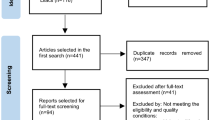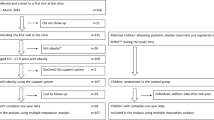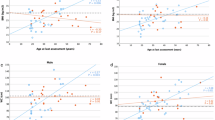Abstract
Objective:
Previous studies have shown that stunting increases the risk of obesity in developing countries, particularly among girls and women, but the underlying reasons are not known. This study aimed to investigate the relationship between stunting, weight gain, and resting metabolic rate.
Design and subjects:
A prospective study was conducted over 36 months with girls from shantytowns in São Paulo, Brazil. A total of 15 stunted girls (S) were compared with 15 nonstunted (N) ones of similar weight for height ratio.
Interventions:
Resting metabolic rate was measured using indirect calorimetry, and the socioeconomic status was determined by interviews in the household. In addition, body composition was measured by skinfold thickness, while the growth rate was calculated dividing the change in weight and the change in height by the follow-up period.
Results:
The results of the present study, when combined, revealed that the S group had a lower resting metabolic rate throughout the follow-up period with the differences being significant at 24 and 36 months of follow-up, associated with an increase in the rate of weight gain and a decrease in lean mass, when compared to the N group.
Conclusions:
These changes are known to be risk factors for obesity and may help to explain the particularly higher prevalence of obesity in women in urban areas of developing countries.
This is a preview of subscription content, access via your institution
Access options
Subscribe to this journal
Receive 12 print issues and online access
$259.00 per year
only $21.58 per issue
Buy this article
- Purchase on SpringerLink
- Instant access to full article PDF
Prices may be subject to local taxes which are calculated during checkout





Similar content being viewed by others
References
Allen LH & Gillespie SR (2001): What works? A review of the efficacy and effectiveness of nutrition interventions. United Nations Administrative Committe on Coordinator/Sub-Committe on Nutrition - ACC/SCN in collaboration with the Asian Development Bank, Manila., Geneva, 123pp.
Amigo H, Bustos P, Leone C & Radrigán ME (2001): Growth deficits in Chilean school children. J. Nutr. 131, 251–254.
Anção MS, Cuppari L, Tudisco ES, Draibe AS & Sigulem D (1993): Programa de apoio a nutrição. 2. ed. São Paulo: Centro de Informática em Saúde/UNIFESP.
Armellini F, Robbi R, Zamboni M, Todesco T, Castelli S & Bosello O (1992): RMR, body fat distribution, and visceral fat in obese women. Am. J. Clin. Nutr. 56, 981–987.
Bonithon-Kopp C, Raison J, Courbon D, Bonhomme G, Guy-Grand B & Ducimetière P (1992): Relationships betweeen 3-y longitudinal changes in body mass index, waist-to-hip ratio, and metabolic variables in an active French female population. Am. J. Clin. Nutr. 56, 475–482.
Cameron N (1984): The Measurement of Human Growth. Australia: Croom Helm.
Crescenzo R, Samec S, Antic V, Rohner-Jeanrenaud F, Seydoux J, Montani J & Dullo AG (2003): A role for suppressed thermogenesis favoring catch-up fat in the pathophysiology of catch-up growth. Diabetes 52, 1090–1097.
De Onis M, Monteiro C, Akre J & Clugstron G. (1993): The worldwide magnitude of protein-energy malnutrition: an overview of the WHO global database on child growth. Bull WHO 71, 703–712.
Deurenberg P, Pieters JJL & Hautvast JGAJ (1990): The assessment of the body fat percentage by skinfold thickness measurements in childhood and young adolescence. Br. J. Nutr. 63, 293–303.
Florêncio TMMD, Ferreira HS, Cavalcante JC, França APT & Sawaya AL (2001): Obesity and undernutrition in a very low income population in the city of Maceió, Northeatern Brazil. Br. J. Nutr. 86, 277–284.
Garn SM, Sullivan T & Victor H (1988): Evidence against functional differences between “central and peripheral” fat. Am. J. Clin. Nutr. 47, 836–839.
Gibson RS (1990): Principles of Nutritional Assessment. New York, USA: Oxford University Press.
Gupta MC (1990): Effect of ascariasis upon nutritional status of children. J. Trop. Pediatr. 36, 189–191.
Hamill PVV, Drizd TA, Johnson CL, Reed RB, Roche AF & Moore WM (1979): Physical growth: National center for Health Statistics Percentiles. Am. J. Clin. Nutr. 32, 607–629.
Hammer LD, Wilson DM, Litt IF, Killen JD, Hayward C & Miner B (1991): The impact of pubertal development on body fat distribution among Caucasian, Hispanic and Asian female adolescents. J. Pediatr. 118, 975–980.
Hoffman DJ, Sawaya AL, Coward A, Wrigh A, Martins P, Nascimento C & Roberts S (2000a): Energy expenditure of stunted and nonstunted boys and girls living in the shantytowns of São Paulo, Brazil. Am. J. Clin. Nutr. 72, 1025–1031.
Hoffman DJ, Sawaya AL, Verreschi I, Tucker KL & Roberts S (2000b): Why are nutritionally stunded children at increased risk of obesity? Studies of metabolic rate and fat oxidation in shantytown children from São Paulo, Brazil. Am. J. Clin. Nutr. 72, 702–707.
Holliday MA, Potter D, Jarrah A & Beargs S (1967): The relation of metabolic rate to body weight and organ size. Pediatr. Res. 1, 185–195.
Holliday MA (1971): Metabolic rate and organ size during growth from infancy to maturity and during late gestation and early infancy. Pediatrics 47, 169–179.
Kurpad AV, Kulkarni RN & Shetty PS (1989): Reduced thermoregulatory in undernutrition. Eur. J. Clin. Nutr. 43, 27–33.
Lohman TG, Roche AF & Martorell R (1991): Anthropometric Standardization Reference Manual Abridged Edition Champagne, IL: Human Kinetics Books.
Martell M, Belitzky R & Gaviria J (1988): Velocidad de crecimiento en niños nacidos pretermino y con bajo peso. In: Crescimiento y desarrolo. Hechos e Tendencias. Publicatión Científica. n. 510, Washington, DC, USA.
Martins PA, Hoffman DJ, Fernandes MTB, Nascimento CR, Roberts SB, Sesso R & Sawaya AL (2004): Stunted children gain less lean body mass and more fat mass than their non-stunted counterparts: a prospective study. Br. J. Nutr. 92, 1–8.
Pelto GH, Urgello J, Allen LH, Chavez A, Martinez H, Menezes L, Capacchione C & Backstrand J (1991): Household size, food intake and anthropometric status of school-age children in a highland Mexican area. Soc. Sci. Med. 33, 1135–1140.
Ravussin E & Swinburn BA (1993): Metabolic predictors of obesity: cross-sectional versus longitudinal data. International J. Obes. Relat. Metab. Dis. 17 (Suppl), 28–31.
Roberts SB, Savage J, Coward WA, Chew B & Lucas A. (1988): Energy expenditure and intake in infants born to lean and overweight mothers. N. Engl. J. Med. 318, 461–466.
Sawaya AL, Dallal G, Solymos G, Sousa MH, Ventura ML, Roberts SB & Sigulem DM (1995): Obesity and malnutrition in a shantytown population in the city of São Paulo, Brazil. Obes. Res. 3, 107s–1115s.
Sichieri R, Recine E & Everthart JE (1995): Growth and body mass index of Brazilians age 9 though 17 years. Obes. Res. 3 (Suppl 2), 117S–121S.
Sichieri R, Siqueira KS, Pereira RA & Ascherio A (2000): Short stature and hypertension in the city of Rio de Janeiro, Brazil. Public Health Nutr. 3, 77–82.
Slaughter MH, Lohman TG, Boileau RA, Horswell CA, Stillmann RJ, Van LMD & Bemben DA (1988): Skinfold equations for estimation of body fatness in children and youth. Hum. Biol. 60, 709–723.
Soares MJ, Peers LS, Shetty PS, Robinson S, Jackson AA & Waterlow JC (1991): Basal metabolic rate, body composition and whole-body protein turnover in Indian men with differing nutritional status. Clin. Sci. 81, 419–425.
Soares-Wynter SY & Walker SP (1996): Resting metabolic rate and body composition in stunted and nonstunted children. Am. J. Clin. Nutr. 64, 137–141.
Spurr GB & Reina JC (1987): Marginal malnutrition in school-aged colombian girls: dietary intervention and daily energy expenditure. Hum. Nutr.: Clin. Nutr. 41, 93–104.
Spurr GB & Reina JC (1988): Basal metabolic rate of normal and marginally undernourished mestizo children in colombia. Eur. J. Clin. Nutr. 42, 753–764.
Spurr GB & Reina JC (1989): Energy expenditure / basal metabolic rate rations in normal and marginally undernourished colombian children 6-16 years of age. Eur. J. Clin. Nutr. 43, 515–527.
Sukkar MY, Kemm JR, Ballal MA & Ahmed TS (1980): Growth velocity in children in rural Khartoum, Sudan. Ann. Hum. Biol. 7, 473–479.
Tanner JM (1969): Growth and endocrinology of the adolescent. In: Endocrine and Genetic Diseases of Childhood, LI Gardner (ed.) pp. 19–69. Philadelphia, WB: Saunders.
Velásquez-Melendez G, Martins IS, Cervato AM, Fornés NS, Marucci MFN & Collho LT (1999): Relationship between stature, overweight and central obesity in the adult population in Sao Paulo, Brazil. Int. J. Obes. Relat. Metab. Dis. 23, 639–644.
Waterlow JC (1976): Classification and definition of protein-energy malnutrition. In: Nutrition in Preventive Medicine: the Major Deficiency Syndromes, Epidemiology and Approaches to Control. GH Beaton and JM Bengoa eds pp 530–555. Geneva: World Health Organization.
Waterlow JC (1977): The presentation, and use of height and weight data for comparing the nutritional status of groups of children under the age of 10 years. Bull. World Health Organization 55, 489–498.
Weiner JS & Lourie JA (1969): Human Biology: A Guide to Field Methods International Biological Programme. IBP Handbook no 9, Oxford, Endinburgh: Blackwell Scientific Publications.
World Health Organization (1995): Physical status: The use and interpretation of anthropometry: report of a WHO expert committee. WHO Techinical Report Series 854. anthropometry: report of a WHO expert committee. WHO Techinical Report Series 854.
Acknowledgements
This work was supported by grants from Fundação de Amparo a Pesquisa de São Paulo (FAPESP) and International Atomic Energy Agency (IAEA).
Author information
Authors and Affiliations
Corresponding author
Additional information
Guarantor: LP Grillo.
Contributors: 1-LPG was responsible for research design, conduction of the study and for the writing the document. AFAS and ACS collected the data. PAM and ITN collaborated in the analysis, interpretation and discussion of the results. ALS was the advisor of the study.
Rights and permissions
About this article
Cite this article
Grillo, L., Siqueira, A., Silva, A. et al. Lower resting metabolic rate and higher velocity of weight gain in a prospective study of stunted vs nonstunted girls living in the shantytowns of São Paulo, Brazil. Eur J Clin Nutr 59, 835–842 (2005). https://doi.org/10.1038/sj.ejcn.1602150
Received:
Revised:
Accepted:
Published:
Issue date:
DOI: https://doi.org/10.1038/sj.ejcn.1602150
Keywords
This article is cited by
-
Nutritional status among primary school children in rural Sri Lanka; a public health challenge for a country with high child health standards
BMC Public Health (2017)
-
Childhood stunting and the metabolic syndrome components in young adults from a Brazilian birth cohort study
European Journal of Clinical Nutrition (2016)
-
The impoverished gut—a triple burden of diarrhoea, stunting and chronic disease
Nature Reviews Gastroenterology & Hepatology (2013)
-
Overweight with concurrent stunting in very young children from rural Mexico: prevalence and associated factors
European Journal of Clinical Nutrition (2007)



